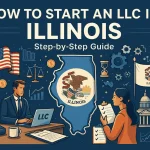Starting an LLC in California? This step-by-step guide covers everything from registration fees to tax requirements, compliance, and filing processes.
Introduction: Why Forming an LLC in California is a Smart Choice
California, the Golden State, is known for its robust economy, diverse industries, and thriving business opportunities. Whether you’re starting a small business in Los Angeles, a tech startup in Silicon Valley, or launching a retail shop in San Diego, forming an LLC in California can offer you valuable protection and flexibility.
An LLC, or Limited Liability Company, helps protect your personal assets from business debts, provides operational flexibility, and offers tax benefits. In this guide, we’ll walk you through every step to form your LLC in California, covering everything from choosing a name to filing necessary documents. Let’s get started!
Step 1: Choose a Unique Name for Your California LLC
Before you can officially form your LLC, you need to pick a name. Your LLC name must comply with California’s naming rules, and it’s essential to make sure that the name is available.
LLC Name Requirements in California:
- Your LLC name must include “Limited Liability Company” or the abbreviations “LLC” or “L.L.C.”
- The name cannot be the same or too similar to an existing LLC or corporation in California.
- Certain words like “bank,” “insurance,” and “trust” are restricted and may require additional paperwork.
Check Name Availability:
- You can check if your desired LLC name is available by searching the California Secretary of State’s database.
- It’s a good idea to also check the availability of your business domain name and consider registering a matching domain.
Step 2: Designate a Registered Agent in California
Every LLC in California must designate a registered agent, which is the person or entity responsible for receiving legal documents on behalf of your LLC. The registered agent must have a physical address in California and be available during regular business hours.
Who Can Be Your Registered Agent:
- Individuals: You or someone you trust can serve as the registered agent.
- Registered Agent Services: Alternatively, you can hire a professional registered agent service.
A registered agent ensures that important legal documents, such as lawsuits or official government notices, are promptly delivered to you. Take a look about the best registered agents in USA for forming an LLC from here.
Step 3: File Articles of Organization (Form LLC-1)
The next step in forming an LLC in California is filing the Articles of Organization (Form LLC-1) with the California Secretary of State. This form officially establishes your LLC.
How to File:
- Online Filing: You can file the Articles of Organization online through the California Secretary of State’s website.
- Mail Filing: Alternatively, you can mail the completed form to the Secretary of State’s office.
Filing Fee:
- The filing fee for the Articles of Organization in California is $70
Information Required:
- LLC name and address
- Registered agent details
- Management structure (member-managed or manager-managed)
Step 4: Create an Operating Agreement
While California does not require you to file an LLC Operating Agreement with the state, it is highly recommended. An Operating Agreement outlines the management structure, ownership, and operational procedures of your LLC.
Why an Operating Agreement is Important:
- It helps prevent future disputes by clearly stating each member’s rights and responsibilities.
- It provides your LLC with legitimacy and shows that your LLC is a separate legal entity from you.
- It helps maintain your limited liability status by demonstrating that your LLC is being operated properly.
Step 5: Obtain an Employer Identification Number (EIN)
An EIN (Employer Identification Number) is required for tax purposes and is essentially your LLC’s Social Security number. It’s needed for opening a business bank account, hiring employees, and filing taxes.
How to Apply for an EIN:
- You can apply for an EIN online for free through the IRS website.
Even if you don’t plan on hiring employees, you’ll still need an EIN if you want to open a business bank account or file taxes.
Step 6: File Statement of Information (Form LLC-12)
After forming your LLC, you need to file the Statement of Information (Form LLC-12) with the California Secretary of State within 90 days of filing the Articles of Organization.
What You Need to Include:
- LLC name and address
- Registered agent details
- Names and addresses of members or managers
- The management structure of your LLC
Filing Fee:
- The filing fee for the Statement of Information is $20.
Step 7: Pay California LLC Taxes and Fees
California imposes an annual franchise tax on LLCs. This tax is due regardless of whether or not your LLC is actively conducting business.
California Franchise Tax:
- The annual minimum franchise tax is $800
- You must file and pay this tax every year, even if your LLC does not generate any income.
LLC Fee Based on Income:
- California also imposes an additional LLC fee based on your LLC’s total income. The fee can range from $900 to $11,790 depending on your income.
Step 8: Comply with Additional California Business Requirements
Depending on the nature of your business, you may need to obtain specific licenses or permits to operate legally in California. This can vary by industry and locality.
Common Licenses and Permits:
- Local Business Licenses: Many cities and counties in California require businesses to obtain a local business license.
- Industry-Specific Permits: If you’re in an industry like food service, healthcare, or construction, you may need additional licenses.
You can use the California Business Portal to learn more about local business requirements and licenses.
Step 9: Maintain Your LLC’s Good Standing
After your LLC is formed, you must maintain good standing by meeting ongoing compliance requirements.
Key Ongoing Requirements:
- File Statement of Information: Every two years, you must file a Statement of Information (Form LLC-12) with the California Secretary of State.
- Pay Franchise Tax: The $800 minimum annual franchise tax is due each year, even if your LLC doesn’t make money.
- File Annual Taxes: File annual tax returns for your LLC with the IRS and the California Franchise Tax Board.
Conclusion: Getting Your California LLC Up and Running
Forming an LLC in California is a great way to protect your personal assets, gain tax flexibility, and establish your business. By following the steps outlined in this guide, you’ll be well on your way to legally registering your LLC in the Golden State.
Remember to stay compliant with all California laws and regulations, file the necessary paperwork on time, and maintain good standing to ensure your LLC’s long-term success.
If you need more information on specific aspects of forming an LLC, such as choosing a registered agent or filing taxes, be sure to check out the other resources available on LLCTutor.com!














